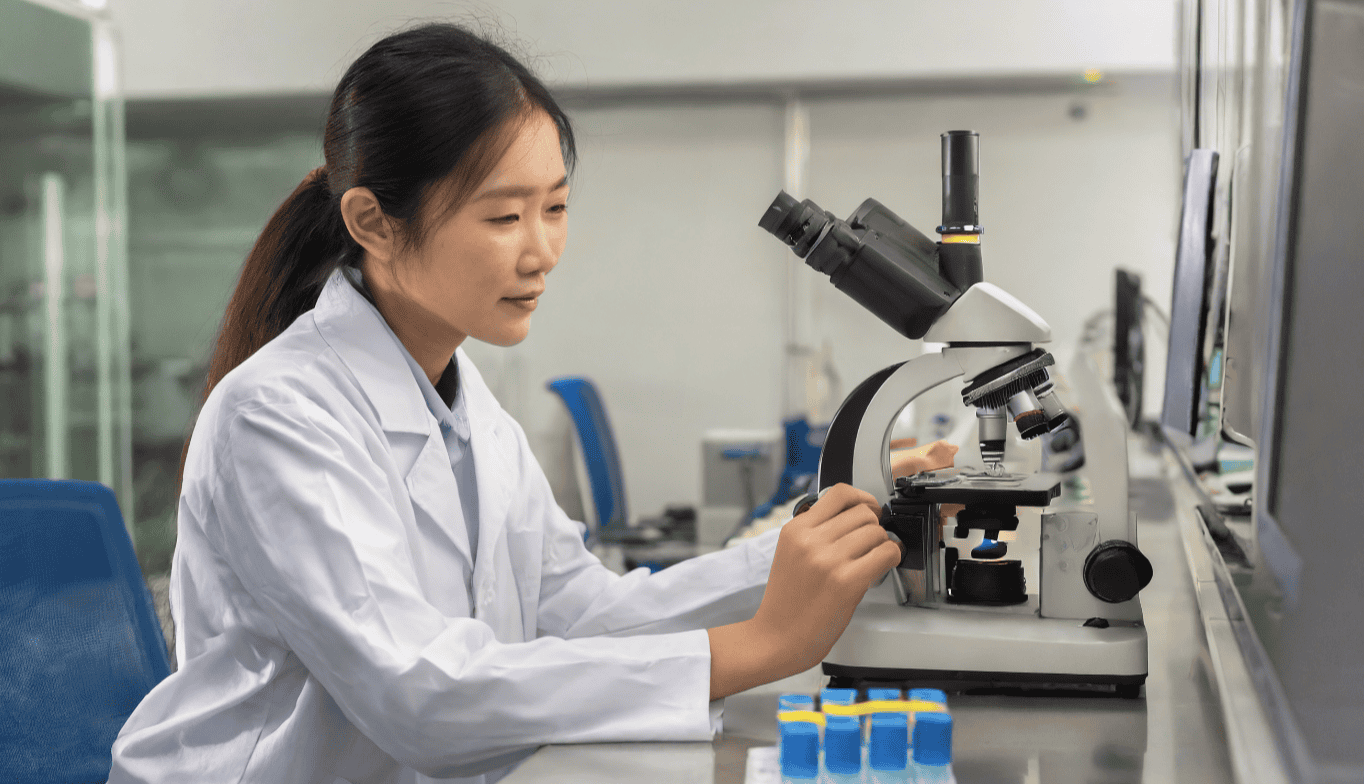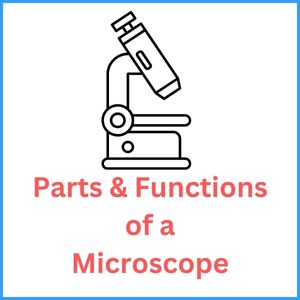
Have you ever wondered what lies beyond the naked eye? The world around us is filled with microscopic objects and organisms, waiting to be discovered.
Thanks to the fascinating field of microscopy, we can unlock the secrets of this hidden realm and witness the magnified view of a whole new world.
In microscopy, scientists use powerful tools, such as scanning electron microscopy, to observe and study objects at a microscopic level. This technique allows for detailed analysis and reveals intricate details that are not visible to the naked eye.
From the intricate structures of insects and parasites to the hidden beauty of archaeological artifacts, microscopy opens up a world of wonders that are otherwise unseen.
Photographer Jannicke Wiik-Nielsen has mastered the art of capturing these invisible wonders through scanning electron microscopy. Her stunning microscope images showcase the beauty and complexity of the microscopic world, offering a glimpse into the amazing intricacies that exist under a microscope.
- Understanding How Scanning Electron Microscopy Works
- Unveiling the Power of Electrons: How Electron Beams are Generated
- Navigating the Vacuum: The Importance of a High Vacuum Environment
- Magnification Magic: Exploring the Role of Magnetic Lenses
- Illuminating the Sample: The Intricacies of Electron Beam Detectors
- Capturing the Details: How Scanning Electron Microscopes Produce Images
- Cracking the Surface: Understanding Secondary Electron and Backscattered Electron Imaging
- Revealing the Exquisite Features of Beetle Larvae and Parasites
- Unveiling the Hidden Beauty of Archaeological Artifacts
- The Alchemy of Scanning Electron Microscopy
- From Everyday Objects to Extraordinary Beauty
- Unlocking the Secrets of Microscopic Organisms
- Final Note
- FAQ
- Source Links
Key Takeaways:
- Microscopy reveals the hidden wonders of the microscopic world.
- Scanning electron microscopy provides high-resolution images of microscopic objects and organisms.
- Photographer Jannicke Wiik-Nielsen captures the beauty of the microscopic world through her microscope images.
- Acquiring knowledge about how SEM works enables us to delve into the intricate details of objects and organisms.
- Exploring the microscopic realm can inspire wonder and curiosity about the world around us.
Understanding How Scanning Electron Microscopy Works
Electron microscopy is a fascinating branch of science that enables us to examine objects at a microscopic level. It utilizes a beam of electrons instead of light to create images, providing us with high-resolution and detailed views of various samples.
One of the most commonly used tools in electron microscopy is the Scanning Electron Microscope (SEM). This instrument uses a focused beam of electrons to scan the surface of a sample, producing detailed images that can reveal valuable information about its structure and composition.
SEM has become a vital tool in many scientific fields, from materials science to biology, allowing researchers to delve into the intricate world of microscopic imaging.
The key components of an electron microscope include an electron gun, electromagnetic lenses, a sample stage, and detectors. The electron gun is responsible for generating the electron beam, which is then focused and controlled by the electromagnetic lenses.
The sample stage holds and positions the specimen under examination, allowing for stability and precise manipulation.
The detectors capture the interactions between the electrons and the sample, providing valuable data for imaging and analysis.
Together, these components work in harmony to produce high-quality images and reveal the hidden details of the microscopic world.
Electron microscopy has revolutionized the way we visualize and understand the tiniest structures and processes, paving the way for countless discoveries and advancements in science and technology.
Unveiling the Power of Electrons: How Electron Beams are Generated
Electron beams, the heart and soul of electron microscopy, are generated through a process known as electron gun operation.
It all begins with the delicate art of specimen preparation, where a thin slice of the sample is carefully mounted onto a tiny microscope grid.
This sample, be it a piece of metal, a biological cell, or even a nanomaterial, is then introduced into the electron microscope chamber where the magic truly happens.
Once inside, the electron beam comes to life, ready to interact with the sample. This interaction is what uncovers valuable information about the specimen’s structure, composition, and properties.
As the electron beam strikes the atoms on the sample’s surface, it causes them to release secondary electrons and backscattered electrons. These emitted electrons carry unique signals that a scanning electron microscope can capture, resulting in an intricate image that reveals the sample’s features and characteristics in astonishing detail.
The generation of electron beams is a fascinating process, one that lays the foundation for the remarkable capabilities of electron microscopy.
Navigating the Vacuum: The Importance of a High Vacuum Environment
The key to unlocking the full potential of electron microscopy lies in the ability to navigate the vacuum. A high vacuum environment is essential for several reasons.
Firstly, it prevents the unwanted interactions between the electron beam and air molecules, which can scatter and distort the path of the electrons. This ensures that the electron beam travels unimpeded and maintains its focused intensity, allowing for high-resolution imaging.
Secondly, a high vacuum environment minimizes the possibility of secondary electron emission. When the electron beam strikes the sample, it can knock off secondary electrons from the surface.
In a high vacuum, these secondary electrons are quickly captured by the electron detector, providing valuable information about the topography and composition of the sample. Without a high vacuum environment, these secondary electrons would be lost due to collisions with air molecules, compromising the accuracy of the imaging results.
In summary, maintaining a high vacuum environment is crucial for achieving microscopic resolution and capturing detailed images in electron microscopy.
It eliminates unwanted interactions with air molecules, prevents the loss of secondary electrons, and ensures the efficiency of the electron detector.
With advancements in vacuum technology, researchers are constantly pushing the boundaries of electron microscopy, opening up new possibilities for exploring the nano-scale world.
Magnification Magic: Exploring the Role of Magnetic Lenses
Magnification magic begins with the role of magnetic lenses in electron microscopy. These lenses are crucial for controlling and manipulating the path of electrons, allowing for precise focusing and magnification of the sample being examined.
By using a combination of electric and magnetic fields, magnetic lenses can bend and shape the electron beam, providing a means to capture intricate details.
Surface imaging is one area where magnetic lenses play a vital role. With their assistance, electron microscopes can produce high-resolution images that reveal topographical information on a sample’s surface.
This level of detail is invaluable in various fields such as materials science, biology, and nanotechnology.
By strategically adjusting the magnetic lenses, researchers can enhance the contrast and resolution of the images, allowing for a more accurate understanding of the sample’s features.
The remarkable capabilities of magnetic lenses are a testament to the advancements in electron optics, revolutionizing the way we explore the microcosmos.
Illuminating the Sample: The Intricacies of Electron Beam Detectors
Electron beam detectors play a crucial role in the world of electron microscopy, as they are responsible for capturing the intricate details of samples under investigation. These detectors are specifically designed to detect the various interactions that occur when an electron beam interacts with a sample.
One such interaction is electron scattering, where the electrons within the beam collide with the atoms in the sample, leading to a scattering of the electrons.
This scattering phenomenon is then detected by the electron beam detector, allowing for the formation of an image.
The intricate intricacies of electron beam detectors enable the detection and analysis of nanoscale imaging, providing scientists with a wealth of information about the structure, composition, and properties of the sample.
By understanding the principles behind electron scattering and image formation, researchers can unlock a world of microscopic exploration, revolutionizing fields such as materials science, biology, and nanotechnology.
Capturing the Details: How Scanning Electron Microscopes Produce Images
Scanning electron microscopes (SEMs) are remarkable imaging tools used in various fields to capture intricate details of samples. The scanning process in SEM involves several key components, with the electron gun and the vacuum chamber playing crucial roles.
The electron gun emits a focused beam of electrons that is directed towards the sample placed inside the vacuum chamber. This low-energy electron beam interacts with the surface of the sample, creating various signals that are used to produce images with exceptional clarity.
In order to capture the details of the sample, the scanning process begins by rastering the electron beam across the surface. The electron beam moves in a zigzag pattern, meticulously scanning the entire sample.
As the beam sweeps over each point, it interacts with the sample surface, resulting in various signals such as secondary electrons, backscattered electrons, and characteristic X-rays.
These signals are then detected and processed to generate high-resolution images, providing invaluable information about the sample’s morphology, topography, and composition.
The scanning process, combined with the utilization of sophisticated electron detectors, enables SEMs to produce images that reveal even the finest details of the samples under investigation.
Cracking the Surface: Understanding Secondary Electron and Backscattered Electron Imaging
When it comes to investigating the surface of materials at a micro level, secondary electron and backscattered electron imaging are two microanalytical techniques that play a crucial role.
These techniques rely on the interactions between the electron beam and the sample to provide valuable information about its composition and topography.
In secondary electron imaging, the electron beam interacts with the atoms of the sample, causing some of the outermost electrons to be ejected. These secondary electrons are then detected and used to generate an image of the surface.
By analyzing the number and intensity of these electrons, researchers can gain insights into the material’s surface features, such as its texture and morphology.
On the other hand, backscattered electron imaging utilizes the electrons that are deflected or scattered back from the sample. This technique provides information about the sample’s atomic number and density, allowing researchers to differentiate between different materials or regions within the sample.
Both secondary electron and backscattered electron imaging rely on precise control of the electron beam, which is achieved through the use of scanning coils that manipulate the trajectory of the electrons.
Understanding the principles behind secondary electron and backscattered electron imaging is crucial for researchers to effectively utilize these techniques in their investigations.
As scanning electron microscopy continues to evolve and advance, there is no doubt that these microanalytical techniques will play an increasingly vital role in unraveling the mysteries hidden beneath the surface of various materials.
By harnessing the power of electron beam interaction and optimizing the use of scanning coils, scientists can push the boundaries of our knowledge and pave the way for innovative applications that have the potential to transform various fields of science and technology.
Revealing the Exquisite Features of Beetle Larvae and Parasites
Scanning electron microscopy (SEM) is an invaluable tool for capturing high-resolution images of insects and parasites, allowing us to unravel the exquisite details of their structures. With the use of an electron beam, SEM provides a magnified view of these microscopic organisms, revealing intricate features that are otherwise invisible to the naked eye.
One of the captivating subjects of SEM photography is beetle larvae. These tiny creatures display an astonishing array of physical characteristics when observed under the electron beam. The detailed portraits captured by photographer Jannicke Wiik-Nielsen showcase the textures, patterns, and unique adaptations of beetle larvae, providing a deeper understanding of their biology.
SEM allows us to witness the hidden world of these organisms, exposing their delicate bodies in stunning detail. With each image, we gain a new perspective on the complexity and beauty that lies within the microscopic realm.
In addition to beetle larvae, SEM also reveals the intricate structures of parasites. By scanning their surfaces with the electron beam, SEM produces high-resolution grayscale images that showcase the subtle details of these organisms. The study of parasites through SEM not only enhances our understanding of their biology but also provides valuable insights for developing effective treatments and prevention strategies.
Through the use of scanning electron microscopy, we are able to explore the hidden world of insects and parasites, uncovering the extraordinary beauty and complexity that exists within these tiny organisms. The high-resolution images captured by SEM not only captivate our visual senses but also provide crucial insights for scientific research and discovery.
| SEM Findings | Key Insights |
|---|---|
| Beetle Larvae | Reveals intricate textures, patterns, and unique adaptations. |
| Parasites | Showcases the detailed structures and physical characteristics. |
| SEM enables a closer look at the microscopic world, unraveling the hidden wonders of insects and parasites. | |
Unveiling the Hidden Beauty of Archaeological Artifacts
High magnification views of archaeological artifacts reveal hidden beauty and provide insights into their craftsmanship and usage. Through the lens of a scanning electron microscope (SEM), these ancient objects come to life, showcasing intricate details that are invisible to the naked eye. By examining microscopic images of archaeological artifacts, researchers can gain a deeper understanding of the materials and techniques used by ancient civilizations.
“SEM imaging allows us to unlock the secrets of the past and discover the true artistry behind these artifacts. We can observe the intricacies of a 17th-century Persian textile, where each silk thread is individually wrapped with thin strips of metal, creating a stunning visual effect. This level of detail provides valuable clues about the trade routes and cultural exchanges of the time,” explains Dr. Karen Smith, an archaeologist specializing in material analysis.
But it’s not just the visible details that SEM unveils. This powerful tool also enables researchers to conduct chemical analysis on artifact surfaces. By using X-ray spectroscopy, scientists can identify elements present in the materials, such as basalt in a roof tile from Gordion, Turkey. This analysis provides valuable insights into ancient trade networks and the sourcing of materials used in these artifacts.
The Hidden Details of Ancient Craftsmanship
| Artifact | Material | Microscopic Detail |
|---|---|---|
| Egyptian Amulet | Gold | The microscopic analysis reveals intricate etchings on the surface, depicting ancient Egyptian symbols and hieroglyphs. |
| Mayan Pottery | Clay | The SEM images display the intricate patterns and carvings on the pottery, showcasing the skill and artistic expression of the Mayan civilization. |
| Roman Coin | Bronze | High magnification reveals the fine details of the coin’s design, including the facial features of emperors and intricate engravings. |
These microscopic investigations contribute to a greater understanding of the past and shed light on the techniques and artistry employed by ancient civilizations. By delving into the hidden beauty of archaeological artifacts, scientists and historians can piece together the puzzle of our collective human history.
The Alchemy of Scanning Electron Microscopy
Scanning electron microscopy (SEM) is a fascinating technique that unveils the hidden secrets of microscopic specimens. By using an electron beam to scan the surface of a specimen, secondary electrons are emitted, providing valuable information about its topography and chemical composition. Through this alchemical process, SEM generates detailed black and white images that resemble topographical maps, showcasing the intricate features of the specimens.
The electron beam in SEM allows for high magnification and resolution, enabling researchers to observe the microscopic world in unprecedented detail. SEM images provide a visual representation of surface details that are not visible under a light microscope. This powerful tool also allows scientists to analyze the chemical composition of specimens, offering insights into the elements present and paving the way for further scientific investigations.
Scanning electron microscopy works like magic, bringing the hidden details of the microscopic world to light. It reveals intricate topographical features and provides a glimpse into the chemical composition of specimens. Through the alchemy of SEM, scientists can unlock the secrets of microscopic organisms and objects, contributing to our understanding of the world at the smallest scale.
Applications of SEM: From Topographical Maps to Chemical Analysis
SEM’s ability to generate topographical maps of specimens is invaluable in various fields of research. It allows scientists to study the surface details of objects and organisms, enabling a deeper understanding of their physical characteristics and functionality. For example, SEM has been instrumental in analyzing the complex structures of polychaetes’ chaetae, which are tiny bristle-like structures that play a crucial role in locomotion and other biological processes.
Additionally, SEM enables chemical analysis by detecting the emissions of electrons during imaging. By studying these emissions, researchers can identify the elements present in the specimens, providing vital information about their chemical composition. This analysis is particularly useful in fields such as archaeology, where the identification of materials used in artifacts can shed light on ancient trade routes and cultural exchanges.
| SEM Applications | Benefits |
|---|---|
| Surface analysis of microscopic organisms | Reveals intricate topographical details |
| Chemical analysis of specimens | Provides insights into the composition of materials |
| Archaeological research | Helps identify materials and understand ancient trade networks |
The alchemy of scanning electron microscopy continues to unlock the secrets of the microscopic world, offering a magnified view and a chemical perspective on the wonders that lie beneath the surface. Through SEM, scientists can analyze the topography and composition of specimens, fostering a greater understanding of the intricate details of the microscopic realm.
From Everyday Objects to Extraordinary Beauty
The world of scanning electron microscopy (SEM) can transform ordinary everyday objects into extraordinary displays of beauty. SEM images provide a magnified view of microscopic details that are not visible to the naked eye, revealing intricate structures and patterns that often go unnoticed. One such example is the study of feathers using SEM, which allows researchers to examine the unique features and colors that make these natural wonders so visually stunning. By understanding the microscopic details of feathers, scientists can gain insights into how birds achieve their vibrant plumage.
Another fascinating application of SEM is the exploration of diatomaceous earth, a common household item with surprising hidden beauty. Diatomaceous earth consists of the tiny skeletons of diatoms, single-celled marine algae, and SEM imaging reveals the intricate and delicate details of these microscopic organisms. The images showcase the intricate patterns and structures that make diatoms so fascinating, highlighting their importance in various ecological processes.
To visually demonstrate the stunning beauty uncovered through SEM, take a look at the image below:
Table: A Comparison of Feathers and Diatoms under SEM
| Feature | Feathers | Diatoms |
|---|---|---|
| Microscopic Details | Barbules, pigmentation, and underlying structure | Skeletal structures, intricate patterns, and surface textures |
| Function | Flight, insulation, courtship displays | Photosynthesis, nutrient cycling, aquatic ecosystem support |
| Size | Varying lengths, depending on the bird species | Microscopic, ranging from a few micrometers to millimeters |
| Diversity | Feather types: contour, down, filoplume, bristle, and semiplume | Over 100,000 diatom species, each with unique forms and structures |
Through the lens of SEM, everyday objects like feathers and diatomaceous earth can be transformed into breathtaking displays of nature’s intricate beauty. These visuals not only captivate the eye but also provide valuable insights into the microscopic world and its importance in various ecosystems.
Unlocking the Secrets of Microscopic Organisms
Scanning electron microscopy (SEM) magnification offers a remarkable opportunity to delve into the hidden world of microscopic organisms. One fascinating example is the study of polychaetes, a diverse group of marine worms. Through the SEM, researchers can uncover intricate details of these organisms that are otherwise difficult to observe with a light microscope.
The SEM allows for a closer examination of minute structures called chaetae, which are bristle-like appendages found on the body of polychaetes. These chaetae, with their distinct shapes and arrangements, play crucial roles in locomotion, sensory perception, and defense mechanisms. SEM imaging reveals the surface details of the chaetae, providing valuable insights into their morphology and function.
Furthermore, SEM analysis enables researchers to go beyond visual observations and delve into the chemical compositions of these microscopic organisms. By utilizing techniques such as energy-dispersive X-ray spectroscopy (EDS), scientists can obtain valuable information about the elemental composition of the specimens. This chemical analysis uncovers the building blocks of polychaetes and contributes to a deeper understanding of their biology and ecology.
“The SEM opens up a whole new world of discovery when it comes to studying microscopic organisms like polychaetes. It allows us to explore their surface details and even obtain insights into their chemical make-up. This knowledge is crucial for understanding the intricate mechanisms and adaptations of these fascinating creatures.”
SEM Analysis of Polychaete Chaetae: Surface Topography and Chemical Composition
| Surface Topography | Chemical Composition |
|---|---|
| SEM imaging reveals the intricate surface details of polychaete chaetae, such as ridges, spines, and branch-like structures. | EDS analysis provides information about the elemental composition of the chaetae, including the presence of calcium, silicon, and iron. |
| SEM allows for the visualization of the fine-scale structures on the surface of the chaetae, which can help researchers understand their functions. | Chemical analysis indicates the potential role of specific elements in the mechanical properties and functionality of the chaetae. |
| Surface topography studies using SEM can contribute to the taxonomic classification of polychaetes, as chaetae patterns vary among species. | By comparing the elemental compositions of different species, researchers can gain insights into the evolutionary relationships and ecological adaptations of polychaetes. |
Final Note
Exploring the microscopic world through magnification and imaging techniques like scanning electron microscopy reveals unseen wonders and provides insights into the intricate details of organisms and objects. From insects and parasites to archaeological artifacts and everyday items, the microscopic realm holds a wealth of beauty and scientific knowledge waiting to be discovered.
Through scientific exploration and public access to microscopy research, you can gain a deeper understanding of the world around you and appreciate the incredible things that exist under a microscope. Discover the unseen wonders that lie beyond the naked eye and delve into the realm of microscopic analysis. With a magnified view, a whole new dimension of scientific exploration awaits.
Uncover the hidden intricacies of insects, parasites, archaeological artifacts, and everyday items. Witness the stunning beauty that lies beneath the surface and embark on a journey of scientific discovery. The magnified view provided by scanning electron microscopy opens up a whole new world of exploration, offering a closer look at the microscopic wonders that surround us.
So, step into the world of scientific exploration, embrace the power of magnification, and unlock the secrets of the unseen. From the smallest organisms to the tiniest details, the microscopic realm holds endless possibilities for discovery and awe. Start your own scientific journey today and uncover the incredible things that await you under the microscope.
FAQ
What is scanning electron microscopy?
Scanning electron microscopy is a technique that uses electrons instead of light waves to provide high-resolution images of microscopic organisms and objects.
How does scanning electron microscopy work?
Scanning electron microscopy works by using an electron beam to scan the surface of a specimen, causing secondary electrons to be emitted. These emitted electrons are then collected and converted into detailed black and white images.
What can be observed with scanning electron microscopy?
Scanning electron microscopy allows for the examination of insects, parasites, archaeological artifacts, everyday objects, and microscopic organisms in incredible detail.
What are the advantages of scanning electron microscopy?
Scanning electron microscopy provides better resolution and reveals intricate details that are not visible to the naked eye. It also allows for the analysis of the chemical composition of specimens.
What is the SEM Lab at the Natural History Museum?
The SEM Lab at the Natural History Museum is a facility that offers visitors the opportunity to explore microscopic worlds and witness the scientific research conducted with scanning electron microscopy.
How can scanning electron microscopy contribute to scientific understanding?
Scanning electron microscopy allows scientists to gain new insights into the microscopic world, contributing to our scientific understanding of objects, organisms, and ancient societies.
Can scanning electron microscopy be used for noninvasive investigations?
Yes, with advancements in imaging technologies, researchers can now study delicate materials and conduct thorough analyses without causing damage.
What are some examples of objects that have been studied with scanning electron microscopy?
Scanning electron microscopy has been used to study insects, parasites, archaeological artifacts, feathers, diatomaceous earth, and microscopic organisms like polychaetes.
How does scanning electron microscopy inspire wonder and curiosity?
By showcasing the microscopic world and the power of magnification, scanning electron microscopy encourages visitors to appreciate the incredible things that exist under a microscope and to ask questions about the world around them.
Why is public access to scanning electron microscopy research important?
Public access to scanning electron microscopy research allows for the sharing of scientific discoveries and insights, contributing to our understanding of human history, the natural world, and the unseen wonders that can be revealed through microscopic analysis.






